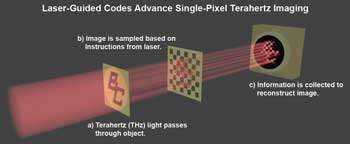
Laser-guided codes advance THz imaging
A single-pixel imaging technique uses laser-guided codes to quickly and efficiently manipulate stubborn terahertz waves, producing clear images in a matter of seconds, which could advance areas such as real-time skin imaging to promote simple skin cancer detection.
Unlike other regions of the electromagnetic spectrum, terahertz has proved extremely difficult to manipulate for capturing images of objects and materials in which these lightwaves interact. Most existing terahertz imaging devices use expensive technology or require several hours and cumbersome manual controls to generate a viable image, according to Willie J. Padilla, a physics professor at Boston College.

A new method for single-pixel terahertz imaging uses a set of instructions delivered by a laser beam to tune terahertz waves to produce new types of terahertz images. During the process, terahertz waves pass through an object (a); then they strike a silicon semiconductor (b) given specific instructions about how to sample the image; that data is passed along to digitally reconstruct an image (c) of the original object in just a few seconds. Courtesy of Claire M. Watts, Boston College.
In the terahertz gap, conventional electronic sensors and semiconductor devices are ineffective. Some systems capture only a fraction of a scene, so tuning these terahertz waves is inefficient.
To tame the terahertz gap, it is crucial to overcome the obstacles of mechanics, cost and image clarity, researchers maintain. A technology that creates efficient masks capable of tuning terahertz radiation to produce clear images in just a few seconds would go a long way toward this goal.
Padilla’s method centers on what he and graduate students David Shrekenhamer and Claire M. Watts call a coded aperture multiplex technique, where a laser beam and electronic signals are used to send a set of instructions to a semiconductor so it can guide the reproduction of the image of an object after terahertz waves have passed through it.
A digital micromirror device encodes the laser beam with instructions that direct certain segments of the silicon mask to react and allow a selected sample of the terahertz waves to pass freely through, consistent with the image pattern. The combination of optical instructions and the semiconductor’s reaction creates a terahertz spatial light modulator, the investigators say.
As with the aperture of a conventional camera, the modulator guides the digital reconstruction of the entire image based on a broad sampling of terahertz waves that have passed through the object.
The method could produce masks of varying resolutions, ranging from 63 to 1023 pixels, and acquire images at speeds of up to 0.5 Hz, or about 2 s. The findings have demonstrated the viability of obtaining real-time, high-fidelity terahertz images using an optically controlled spatial light modulator with a single-pixel detector, the researchers said.
Additional laboratory research is enhancing terahertz wave control; intricately patterned metamaterials, for example, are being used to manipulate terahertz waves for faster and more efficient image creation, Padilla said.
The research was published in Optics Express (doi: 10.1364/OE.21.012507).
Published: September 2013